Portugal’s underrated dry wines

Fine (and inexpensive) : both red and white
2 December 2019
By Panos Kakaviatos for wine-chronicles.com
Lunching late last month at the upscale JNcQUOI in Lisbon cost a friend and myself €155 not including tip, but the restaurant’s bustling French brasserie style ambiance with elegant furnishing and décor, matched by superb dining options, make this two-year old restaurant worthy of at least one Michelin star.
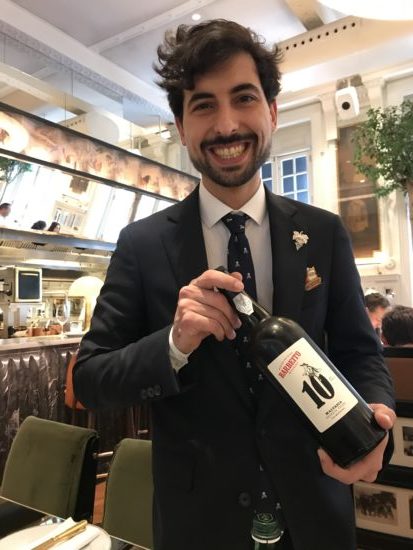
Some 1,000 references, 600 Portuguese : sommelier Diogo Yebra
The wine list counts an impressive 1,000 references, including such global and rare celebrities as Pétrus and DRC, Sine Quoi Non and Sassicaia. But 600 of them are more affordable Portuguese wines, proving yet again how delicious dry reds and whites can be from this great Old World wine producing country.
A case in point is the Antonio Maçanita Palpite Reserva 2018 vintage white of Alentejano. Palpite means “feeling”, as in I’ve got a feeling it will rain tonight, but I had more than a feeling that this wine is great, and not just because sommelier Diogo Yebra calls it “my favorite dry white of Portugal”.
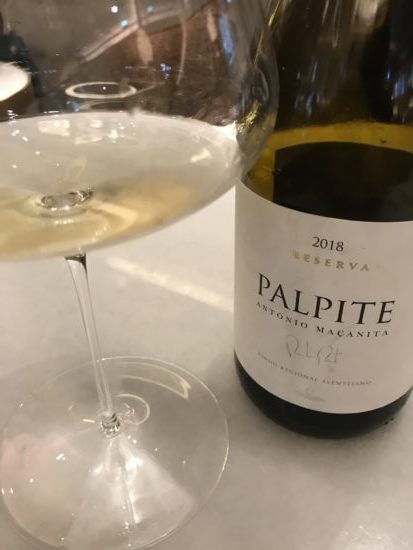
Love this white!
The brisk salinity and elegant pear skin notes, with a touch of clove, perhaps coming from the 30% new oak aging during 12 months, excite the taster. It also has a smooth, yet contoured texture, perhaps more than just medium-bodied. One gets a sense of premier cru Chablis from a ripe vintage, and a hint of more oak-driven Meursault, although there is no Chardonnay in the blend of this €28 per bottle (retail cost) field blend of 70% Arinto (known for its lemony and wet stone like aspects), 13% Tamarez, 7% Alicante Branco and 5% each of Antao Vaz and Verderlho.
It is interesting to note that the wine is made in Alentejo region, using the Vinho Regional designation Alentejano VR, rather than the “higher” Denominação de Origem Controlada (DOC) level under the designation Alentejo DOC.
In a word, “Burgundian” comes to mind and for a very good price! And although it does not match the depth of a premier cru Chassagne Montrachet for example, it also does not cost nearly as much – and proved to be my favorite dry wine that I tried in a short stay in Lisbon, out of some 12 wines that I tried during my short visit, which was actually for my other work at the Council of Europe (a conference on sustainable development).
Not fully breaking out
Ask most wine promoters, and they often enthusiastically explain how great Portuguese dry white and red wines are. A recent Wine Spectator Top-100 poll included several dry Portuguese wines in the top 20 of that list, according to Master of Wine Konstantinos Lazarakis. In the 2014 ranking of the magazine, a dry red from the Douro came in fourth place. When I went to the Digital Wine Conference in Rioja Spain in 2013, I took part in a media tour of the Douro Valley, where I also tasted excellent dry Portuguese wines.
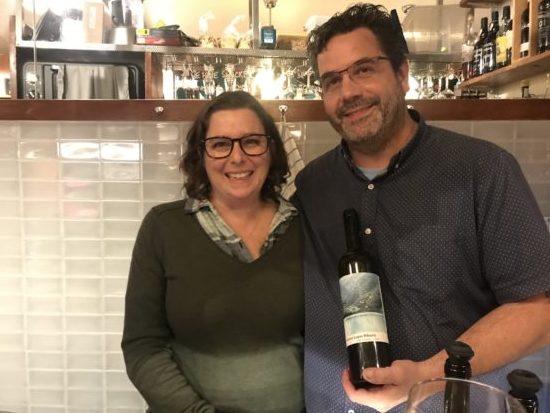
Jen and Brian, holding a darn good red.
For a less upscale approach, I also visited the recently opened Black Sheep wine bar, billed aptly as “Lisbon’s smallest wine bar”, as barely 10 people can fit into the cozy space. The friendly feeling recalls that classic U.S. television series Cheers. Everyone may not know your name, but owner Brian Patterson, a 20-year veteran of the wine business, and his wife Jen have cultivated a much appreciated local following, with fine, affordable choices that never go beyond €6 a glass. By contrast, I just had oysters at Hank’s Oyster Bar in Washington D.C. the night before I posted this text, and the by-the-glass selection came across uninspired with somewhat average Sancerre for a whopping $16 a glass!
I liked most of the wines that I tried at Black Sheep, but Patterson echoed what Forbes writer Courtney Schiessl noted earlier this year: “Portugal often gets overshadowed by its larger next-door neighbor, Spain, and that’s a shame.”
Part of that reason, argues Patterson, is a lack of the same food identification as Spain or Italy. “When you think of Portuguese food, what comes to mind,” he asks me rhetorically. It is not the same as with Spanish or Italian food.
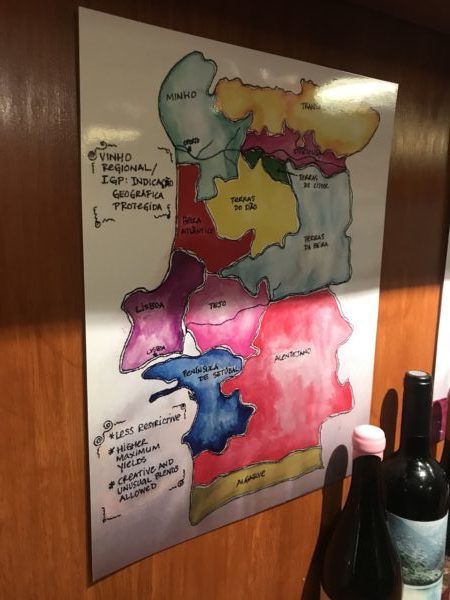
Wine bar, wine map 🙂
Many more Americans know about tapas, tortillas and paella or pasta, risotto and ossobuco than they would about bacalhau or sardinhas asadas. Indeed, Patterson’s point is that Spain and Italy have many more restaurants in the U.S. than Portugal does, and “the wine long since has followed”.
Although Portugal falls into the top 10 wine exporters in the world by value (albeit including its famous fortified wines), it lags far behind Spain and Italy and, of course, France. Last year’s top three countries that exported the highest U.S. dollar value worth of wine were France at US $11 billion (29.5% of total wine exports), Italy at $7.3 billion (19.6%) and Spain at $3.5 billion (9.4%). Portugal, by contrast, had a level of export over 10 times less than that of France, at $952.1 million (2.5%).
Another issue that impedes sales is nomenclature, adds Patterson. It is easier to pronounce Chianti and Rioja than, say, Tinta Roriz, Tourgia Nacional or Encruzado.
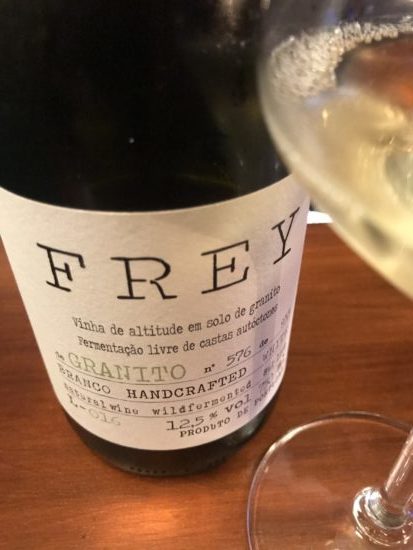
Wine bar whites
Patterson poured me an excellent and rather rare Frey 2016, a field blend of white grapes including Malvasia and Rabigato, clocking in at 12.5% alcohol. Only 933 bottles of this are made from vines in the Douro region, on granitic soils at 600-700 meters in the Douro left bank area near a town called Lamego. Perhaps it was the Rabigato that lent most of that body and acidity? The wine exudes a lovely, salty aspect, an iodine brisk nose with a “soft” palate and mineral wet stone and zesty citrus aromas and flavors. Clean as a whistle on the palate. This can be categorized as a “natural wine” with minimal sulfites used, and it is excellent. It also lacks official DOC appellation status, because the winemaker “is not following all the rules”, Patterson said. Good for the winemaker. At €6 a glass, well worth it!
The second dry white I tried was the Casa de Mouraz Encruzado 2017, made from the single white wine grape Encruzado. This grape is grown almost exclusively in the Dão region, situated in the Região Demarcada do Dãowith the Dão-Lafões sub region of the Centro, Portugal. One of the oldest established wine regions in Portugal, Dão wine is produced in a mountainous area with a temperate climate, in the area of the Rio Mondego and Dão rivers in the north central region of the country. The region became a DOC in 1990 and is the origin of the famous Touriga Nacional grape that is the principal component of Port wine. In any case, this wine came across a bit headier, a bit more “tropical” than the previous white, showing off its 13.5% alcohol. Certified organic, it is made from vines in the Mourraz village in the center of Dão. No oak aging but lees aging for eight months lends richness to the wine, which comes across with ripe white stone fruit, also brisk and fresh.
Wine bar reds
“Tretas!” (This means “Bullshit!”) As in, “Just enjoy the wine” and do not get too complex about how it is made (what the producer intends). This red is lighter and somewhat volatile in aspect, too. It blends various grapes, also made from the Dão region. A bit simple, a bit like Beaujolais with some “natural wine” funkiness that did not truly resonate to me. €4 a glass.
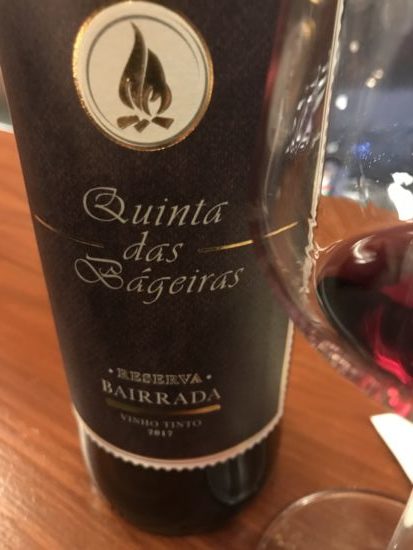
Quinta das Bageiras Reserva Bairrada DOC 2017. Love the brambly red fruit with touches of spice. Here a more classic producer (no natural wine funkiness), but still natural yeast fermentation, in open stone vessels and then aged in 600- to 1000-liter chestnut foudres. The wine blends 60% Baga and 40% Touriga Nacional from vineyards at low elevation (almost sea level) south of Porto. Whole cluster fermentation lends structure. Bottled without fining or filtration and less than 10,000 bottles made. 13% alcohol. At only €5 a glass, a deal.
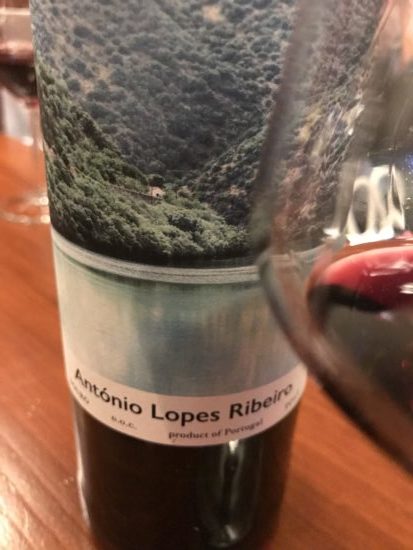
My overall favorite red
One of my favorite reds I enjoyed at the wine bar was the Antonio Lopes Ribeiro Douro DOC 2015 vintage, which you can find even today in the U.S. for under $25 a bottle. Certified organic, and made from vines grown on the rocky schist slopes that surround the Douro River, it blends 60% Touriga Franca and 10% each of Touriga Nacional, Tinta-Barroca, Tinta-Roriz (Tempranillo, in Spanish) and Sousao. Elegance and complexity indeed, with an almost concentrated sense of crushed herbs, black olive and tomato paste. Very flavorful? Yes. And just €5.50 a glass. Great deal! 13.5% alcohol.
Going upscale
Back at the upscale JNcQUOI, sommelier Diogo Yebra says that the main problem for successfully selling more Portuguese dry wines has been a “cheap image” for Portugal due in part to inexpensive Vinho Verde, literally meaning green wine. It is not a grape variety, but a DOC for wine production that is most associated with cheap white wines.
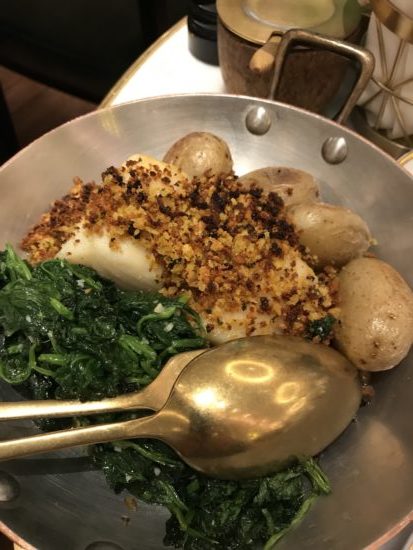
Now that’s bacalhau!
The restaurant is as far as you can get away from that cheap image. Certainly the food here can lead to a greater wine following, as wealthy foreign tourists sample arguably the best bacalhau I have ever had. Is anyone asking what this is It is the Portuguese word for cod and—in a culinary context—dried and salted cod, which, at its worst, is far too salty. But here it was at its best, with corn bread crumbs and delectable spinach and roasted potato. Yebra explained why bacalhau is “neither fish nor meat” when it comes to wine pairing, because it is dried in salt, which, along with the texture of the fish, permits it to stand up to some reds. The corn bread crumbs added texture on the palate and the roasted potatoes lent more substance for a red wine pairing that worked well.
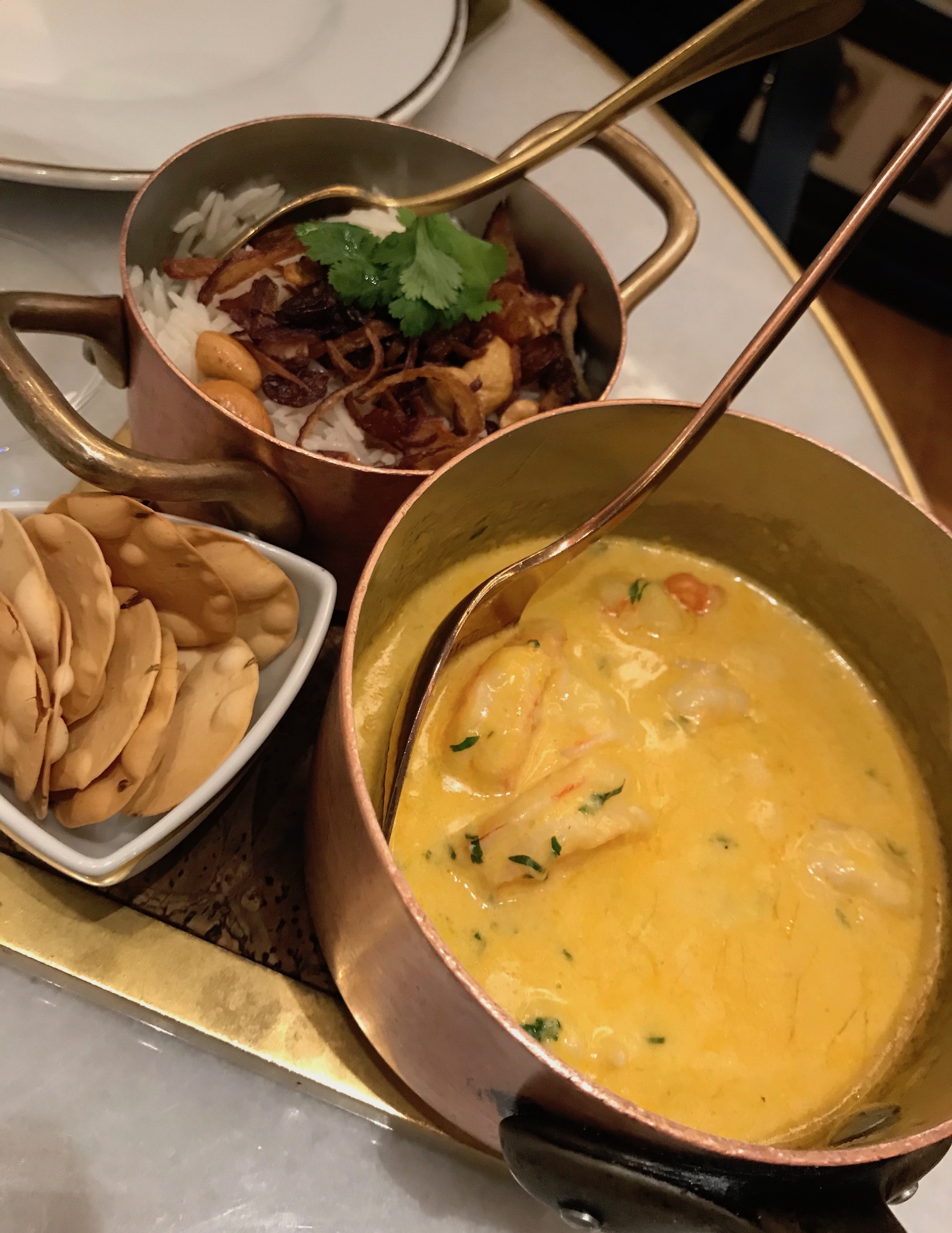
Stood up to the reds.
Even though the lunch cost us €155, not including the tip, the same quality along with the wines would cost at least 50% more in New York or Paris to be sure. Yebra says “our focus should be to make world class wines that can compete with top dry wines from other famous regions”. Interestingly, when I asked for bottled sparkling water, at the start of lunch, a waitress initially brought San Pellegrino, so I asked for Portuguese water, which comes from the Douro region.
My friend ordered seared shrimp dipped into red curry and coconut sauce, see picture above, lending the serving enough texture to stand up to a red wine blending Tinto Roriz and Touriga Nacional.
After delicious marinated olives, fine local breads but then with … French butter, we began with white wines.
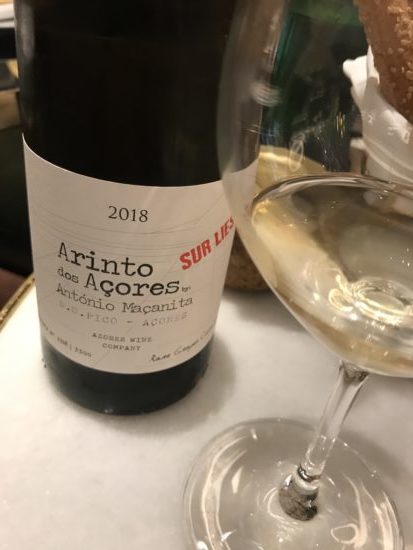
The first wine, Arinto dos Açores Antonio Maçanita DOC Açores 2018, is made of 100% Arinto that reminded me of a fine Pinot Blanc. Pretty simple, but not without finesse, all rather smooth with a hint of seafaring aromatics. Medium bodied. Balanced. More stone fruit than citrus. It was interesting to note that the vines on the Azores for this wine are planted below fog on volcanic soils, but also needing protection from sea tides, so barriers are built to prevent them from getting flooded. Interesting!
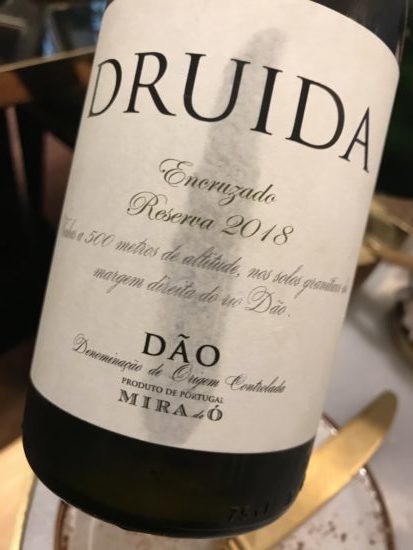
Next came what Yebra calls the “Chardonnay of Portugal”, indeed the Encruzado grape already described above. This Druida Encruzado Dão DOC 2018 costs just over €20 at an upscale retail shop, as you can see in the title picture for this post. It is made from grapes grown on vines 500 meters in altitude. At 12.5% alcohol, it came across as more elegant and less tropical than the Encruzado that I had tried at the wine bar the preceding evening. A smooth and more citrus-driven wine, but with almost full body and elegance, costing only €15 retail. Nice deal. This latter wine especially paired well with what my friend ordered: a light tomato-infused fish soup starter, with shrimp, cod and pasta, along with dill herbs, whose vivid flavors of the sea were balanced by the body of the Druida. I had a cream of green asparagus soup with white truffle shavings that perhaps demanded a more full-bodied wine of some maturity to match the truffle. But it was a difficult pairing, given the asparagus.
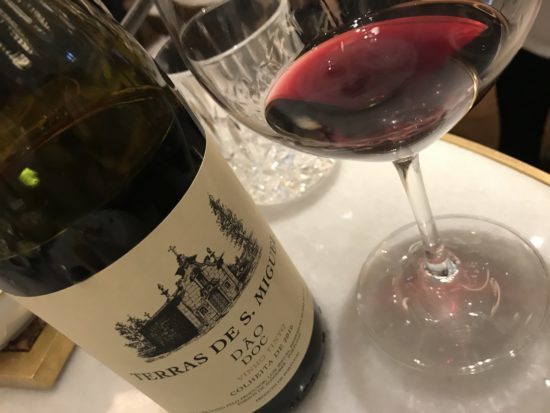
The first dry red for lunch was the Terras De S. Miguel Colheita de 2016 Dão DOC, a smooth wine, with red berry and plum, medium-bodied and blending Touriga Nacional and Tinta Roriz (Tempranillo in Spanish). Not very tannic and it paired well with the shrimp in the red curry coconut cream sauce. Pictured above.
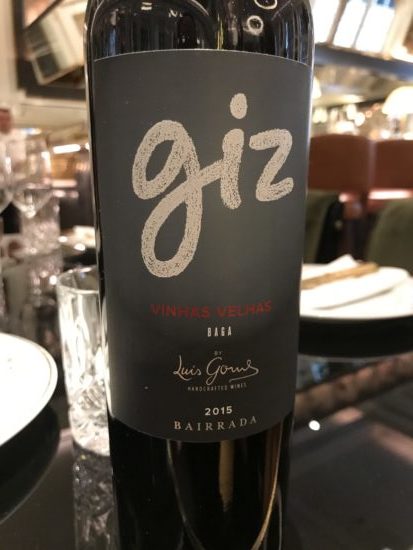
Silly label, but good wine.
The Giz Vinhas Velhas Luis Gomes Baga Bairrada DOC 2015 came across more tannic, but again rather soft and with greater breadth on the palate than the preceding wine, with more density along with a touch of vanilla spice no doubt from the 20 months of aging in French oak. What the sommelier said about the bacalhau being “neither fish nor meat” applied here as even this broad and oak influenced red was matched well by the fish, although I think the lighter red above proved a more agreeable combination.
Could Trump tariffs be a blessing for Portugal?
Given quality of the red and white dry wines I tried, mostly not made from well known producers who charge higher premiums, it is safe to say that these wines are underrated or “under the radar” of many a wine lover. Could the possibility of longer-term Trump tariffs that exclude Portuguese wine work in Portugal’s favor?
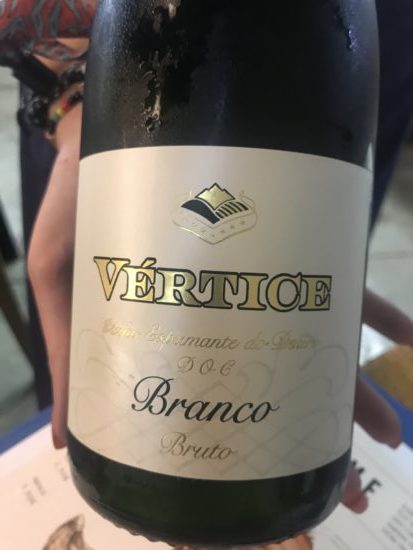
Loved this bubbly: in Lisbon and in Washington D.C.
Although Trump tariffs do not apply to Champagne from France, it is worth noting also how good Portuguese bubbly can be – and affordable. When I dined one other evening before my departure from Lisbon last month, at the excellent seafood and fish restaurant Sea Me, I enjoyed a fine bubbly, made in the traditional (Champagne) method that only cost me €27 a bottle, restaurant price. It lacked the depth of top-flight Champagne, but is as good as, if not better than, lower end NV Champagne or Alsatian Cremant. It has a brisk lemon-lime palate with some subtle toast notes and invites further sips: as good with oysters as it was with Tennessee smoked ham on a biscuit that I enjoyed here in the U.S. over the long Thanksgiving weekend, after having purchased a bottle of it again at Lisbon Airport for €15.
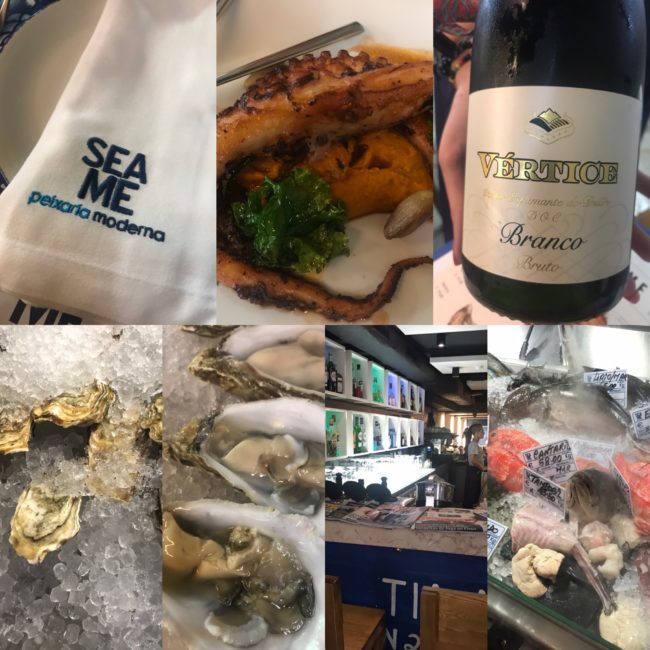
Fish and seafood choices are aplenty in Lisbon, but Sea Me is a top address. Go for it!
A special word as well for Sea Me: This is a fabulous address for fine dining when in Lisbon, with superb briny oysters, delectable grilled octopus and a large crab to share. With the bottle of wine and a superb dessert of vividly flavored ice creams (creamy cherry, yuzu and salted caramel), the cost was just €120 for two, excluding tip. If in Lisbon, go to Sea Me!
Disparities on a local level
One other observation, concerning the rising costs of living in Lisbon, where I arrived for a sustainable development conference, organized by the Council of Europe’s North South Centre: Renting a small room in the city I was told comes out to €500 a month. Lisbon can be seen as a victim of its own success, with more and more non Portuguese buying up properties, driving up prices and renting out as Air B&Bs. An Uber driver told me: “We can no longer afford to live in our own city”.
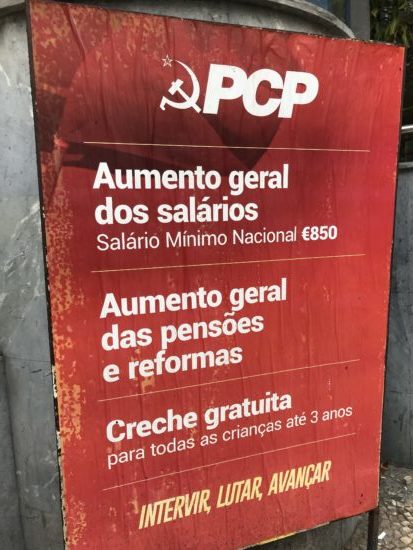
Many pro Communist postings in the city, this one just next to JNcQUOI. Increasing income disparities brings more discontent among locals.
Anyway, Lisbon is gorgeous and the people are very kind.
But you see luxury shops on one end, and posters for the Communist party on the other. Almost just next to each other in fact, in the two pictures. Quite a juxtaposition.
Many thanks to Portuguese wine expert Andre Ribeirinho for recommending both the Black Sheep wine bar and the upscale JNcQUOI.
I’ll be back soon!
Category: Blog Tagged: Alentejo, Antonio Lopes Ribeiro Douro DOC, Antonio Maçanita Palpite Reserva 2018, Arinto, Baga, Black Sheep Wine Bar, Dão, Douro, JNcQUOI, Portugal, Tinta Roriz, Touriga Nacional, wine
 Wine Chronicles
Wine Chronicles
Share This